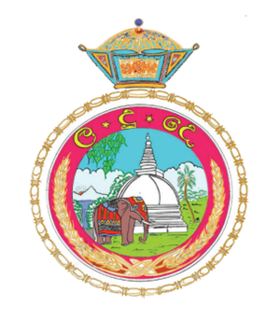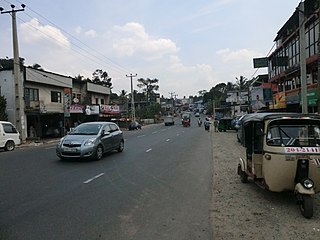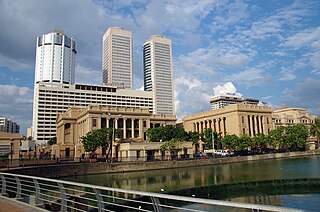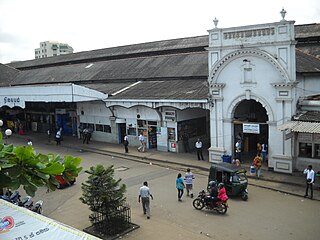
Colombo is the commercial capital and largest city of Sri Lanka by population. According to the Brookings Institution, Colombo metropolitan area has a population of 5.6 million, and 752,993 in the city proper. It is the financial centre of the island and a tourist destination. It is located on the west coast of the island and adjacent to the Greater Colombo area which includes Sri Jayawardenepura Kotte, the legislative capital of Sri Lanka and Dehiwala-Mount Lavinia. Colombo is often referred to as the capital since Sri Jayawardenepura Kotte is within the urban area of, and a suburb of, Colombo. It is also the administrative capital of the Western Province and the district capital of Colombo District. Colombo is a busy and vibrant city with a mixture of modern life, colonial buildings and monuments.

Homagama is a town in the Colombo District, Sri Lanka, about 24 kilometres (15 mi) south-east of Colombo. The Homagama Pradeshiya Sabha consists of the Homagama divisional secretariat and 10 GN division of Padukka DS division. The total Land area is about is 137 square kilometres (53 sq mi) of 90 GN division. The Pradeshiya Sabha was established under act No 15 of 1987, and has the highest population of any pradeshiya sabha area in Sri Lanka. It is home to notable places such as the campus of the National School of Business Management, Sri Lanka Institute of Nanotechnology, the Panagoda Cantonment, Upali Newspapers, Mahinda Rajapaksha College Homagama, St. Michael's College, Homagama, Buddhist and Pali University of Sri Lanka, Ceylon Biscuits Limited and the Laxapana Battery Company.

The Sri Lanka Railway Department is Sri Lanka's railway owner and primary operator. As part of the Sri Lankan government, it is overseen by the Ministry of Transport. Founded in 1858 as the Ceylon Government Railway, it operates the nation's railways and links Colombo with other population centres and tourist destinations.

Pannipitiya is a suburb of Colombo city. It is an area in Colombo District, Sri Lanka and is located about 15 km from the commercial capital. Pannipitiya is subdivided into a number of smaller areas.

Samaraweera Mudalige Don Premakeerthi de Alwis, popularly known as Premakeerthi de Alwis, was a Sri Lankan radio and television broadcaster and lyricist. Considered as an iconic figure in Sri Lankan radio television history, he was assassinated during the 1987–89 JVP Insurrection at the age of 42.

Kottawa is one of main suburbs in Colombo and is administered by the Maharagama Urban Council. It is located 21 km (13 mi) from the centre of Colombo.

Borella is the largest suburb in Colombo, Sri Lanka represented by divisional code 8.

Dematagoda is a suburb in Colombo, Sri Lanka represented by divisional code 9. It is surrounded by the Borella, the Maradana and the Kolonnawa. The Baseline Road passes through the Dematagoda. The famous Sri Lankan Tamil broadcaster of Radio Ceylon fame, B. H. Abdul Hameed was born in Dematagoda.

Fort (Colombo) is the central business district of Colombo in Sri Lanka. It is the financial district of Colombo and the location of the Colombo Stock Exchange (CSE) and the World Trade Centre of Colombo from which the CSE operates. It is also the location of the Bank of Ceylon headquarters. Along the foreshore of the Fort area is the Galle Face Green Promenade, built in 1859 under the governance of Sir Henry George Ward, the Governor of Ceylon during British colonial era. Fort is also home to the General Post Office, hotels, government departments and offices.

Kirulapone (Kirulapana) is a suburb in Colombo, Sri Lanka which is also known as Colombo 5.

The electricity sector in Sri Lanka has a national grid which is primarily powered by hydroelectric power and thermal power, with sources such as photovoltaics and wind power in early stages of deployment. Although potential sites are being identified, other power sources such as geothermal, nuclear, solar thermal and wave power are not used in the power generation process for the national grid.

Alexander Ekanayake Gunasinha trade unionist and politician. A pioneering trade union leader, known as the "Father of the Labour Movement", he was the founder of the Ceylon Labour Party, Sri Lanka's first labour organisation. A former Mayor of Colombo, he served as the Minister without portfolio, Minister of State and Chief Government Whip in the First Parliament of Sri Lanka and Ceylon's Ambassador to Burma and Indonesia.
Godagama is a suburb of city of Colombo Sri Lanka. It is located in Colombo District within the Western Province, Sri Lanka.

The Weston-super-Mare Tramways were the electric street tramways of the seaside resort of Weston-super-Mare in Somerset, England. It operated a fleet of up to 16 standard gauge single- and double-deck tramcars on routes totalling 2.92 miles (4.70 km) to Birnbeck Pier, The Sanatorium and Locking Road. It opened in 1902 and was replaced by bus services in 1937.

Fort railway station is a major rail hub in Colombo, Sri Lanka. The station is served by Sri Lanka Railways, with many inter-city and commuter trains entering each day. Fort Station is the main rail gateway to central Colombo; it is the terminus of most intercity trains in the country.
Llanelly and District Electric Tramways operated a standard gauge tramway service in Llanelli, Wales, between 1908 and 1933. It was the successor to a 3 ft gauge horse tramway, which ran from 1882 until 1908. A complex series of negotiations took place in the early 1900s, resulting in the horse tramway being converted to an electric tramway. Standard gauge horse trams were run initially, until the company completed North Dock power station, which supplied electricity to the tramway. Two of the employees who worked on the construction went on to found Balfour Beatty.

The Pettah Floating Markets are located on Bastian Mawatha in Pettah, a neighborhood in Colombo, Sri Lanka, and consist of 92 trade stalls, with a number of the stalls established on boats on Beira Lake. The floating market serves as a tourist attraction selling local produce and local handicraft.

The Perugia Tramway opened in 1899, which was the same year as that in which electric street lighting came to the city. The purpose of the Tramway was to link the historical city centre with the city's railway station, some 3 km away down the hill.
Pettah Power Station was a thermal power station in Colombo in south western Ceylon.

Kanatte Cemetery, also known locally as Borella Cemetery, is Colombo's main burial ground and crematorium.



















